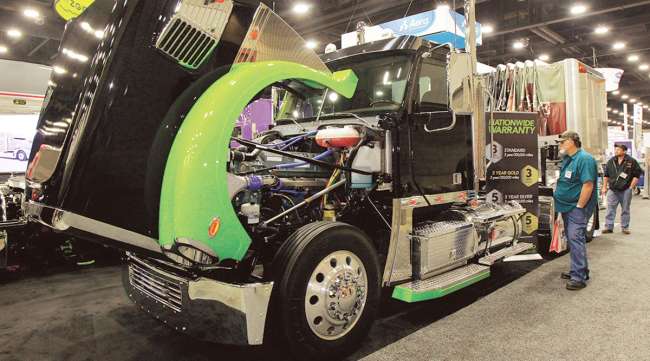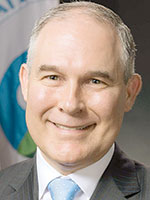Senior Reporter
EPA Urged Not to Repeal Rule Regulating Glider Truck Emissions

Dozens of representatives for trucking trade associations, health and environmental nonprofits, private citizens, truck dealers and manufacturers on Dec. 4 urged the U.S. Environmental Protection Agency not to repeal a provision in the 2016 Obama administration Phase 2 greenhouse gas reduction rule to regulate emissions requirements for glider kits.
At an EPA hearing, about 60 people testified that the estimated 10,000 glider kits currently in existence — trucks with new chassis but older remanufactured engines — were among the “oldest, dirtiest, deadliest” vehicles on U.S. highways.
The EPA hearing was held in response to a proposed rule issued last month to repeal medium- and heavy-duty truck Phase 2 greenhouse gas emission and fuel efficiency standards for the glider industry.
“The previous administration attempted to bend the rule of law and expand the reach of the federal government in a way that threatened to put an entire industry of specialized truck manufacturers out of business,” EPA Administrator Scott Pruitt said in a recent statement.

Pruitt
Pruitt said that gliders not only provide a more affordable option for smaller owners and operators, but also serve as a key economic driver to numerous rural communities.
But the majority of those commenting at the hearing blasted the repeal plan with claims that ranged from detailing the effects of truck pollution to blunt accusations that Pruitt is more concerned with the health of the glider kit industry than the U.S. population.
A decade ago, glider kits in the United States were mostly limited to vehicles that had been in an accident that left the body unrepairable, but the powertrain still intact, Rachel Muncrief, who directs the heavy-duty vehicles program for the International Council on Clean Transportation, told EPA officials.
But in recent years, sales of gliders have increased exponentially as a “deliberate attempt by glider kit manufacturers and assemblers to circumvent emissions control regulations,” Muncrief said.

Alt
Susan Alt, senior vice president of public affairs for Volvo Group North America, said that these days most glider buyers are not small operators, but often medium and large fleets.
“The EPA recently conducted comparison testing of late model glider vehicles with late model OEM products,” Alt told EPA officials. “EPA found that glider vehicles emitted 43 times more [nitrogen oxides] and 55 times more soot in highway conditions compared to today’s low-emission diesel vehicles.”
Glen Kedzie, vice president and energy and environmental counsel for American Trucking Associations, said that by EPA’s own admission, glider vehicles may account for as much as 33% of total NOx emissions from all heavy-duty on-highway vehicles by 2025 if left unchecked.
ATA opposes a repeal of the glider provision, Kedzie said.
“It is well-known that gliders are purchased to save money, avoid maintenance costs and weight penalties, skirt federal excise tax payments, elude the use of engine technologies that virtually eliminate NOx and PM emissions, and to avoid the installation of safety equipment in pre-2000 vehicles under the electronic logging device rule which goes into effect Dec. 18,” Kedzie told EPA officials.
Luke Tonachel, Director of the Clean Vehicles and Fuels Project at the Natural Resources Defense Council, said the repeal of the glider provision would “open a deadly, dirty truck loophole” that could lead to thousands of premature deaths.
“This is astounding and dangerous,” Tonachel said. “Allowing this to occur, completely goes against EPA’s mission to safeguard public health by ensuring that we have clean air.”
Patrick Quinn, executive director of the Heavy Duty Fuel Efficiency Leadership Group, said his organization is concerned that EPA’s decision to encourage the continued growth of the glider industry undermines the significant emissions reduction investments of many motor carriers.
“EPA’s proposed repeal of emissions requirements for gliders has the anticipated effect of expanding glider production,” Quinn said. “Truck and engine manufacturers will face a significant competitive disadvantage.”
“Here we have Scott Pruitt’s EPA trying to pull a fast one on us in plain sight,” said Molly Rauch, public health policy director for the New York City-based Moms Clean Air Force. “As moms who care about our children’s health, we say, ‘no.’”
“This is just one part of an all-out assault on public health from EPA. This EPA is showing a support for dirty tailpipes and dirty smoke stacks.”
“The consequences of reversing the common-sense 2016 standards are far from esoteric,” said Rep. Jamie Raskin (D-Md.). “I am baffled and confounded as to why the EPA would even consider repealing such an important, well-designed and effective public health rule.”
“I’m mystified as to why EPA would today consider reopening a loophole to allow outdated killer diesel engines to re-pollute our air in the form of glider vehicles. Where is the lobby for turning the clock back to more and more deadly air pollution?”


